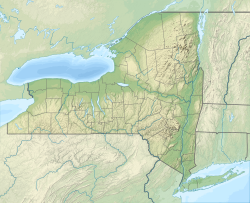| Oneida Creek | |
|---|---|
 Oneida Creek upstream of Swallow Bridge Road | |
| Location | |
| Country | United States |
| State | New York |
| Counties | Madison, Oneida |
| Cities | Oneida, Sherrill |
| Physical characteristics | |
| Source | |
| • location | Town of Smithfield, Madison County |
| • coordinates | 42°59′01″N75°40′46″W / 42.98361°N 75.67944°W [1] |
| Mouth | Oneida Lake |
• location | South Bay, Town of Lenox, Madison/Oneida county border |
• coordinates | 43°09′52″N75°44′17″W / 43.16444°N 75.73806°W [1] |
| Discharge | |
| • location | Oneida [2] |
| • average | 175 cu ft/s (5.0 m3/s) [2] |
| • minimum | 9.5 cu ft/s (0.27 m3/s) (September 6, 1999) [2] |
| • maximum | 11,400 cu ft/s (320 m3/s) (June 28, 2013) [2] |
| Basin features | |
| Waterfalls | Stockbridge Falls |
Oneida Creek is a small river in New York in the United States. [1] The creek enters the southeastern corner of Oneida Lake at a location known as South Bay, a bay of the lake. The name is derived from the Oneida tribe of the Iroquois. Stockbridge Falls is located on Oneida Creek.

